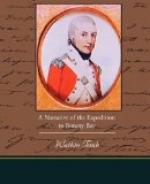Previous to leaving England I remember to have frequently heard it asserted, that the discovery of mines was one of the secondary objects of the expedition. Perhaps there are mines; but as no person competent to form a decision is to be found among us, I wish no one to adopt an idea, that I mean to impress him with such a belief, when I state, that individuals, whose judgements are not despicable, are willing to think favourably of this conjecture, from specimens of ore seen in many of the stones picked up here. I cannot quit this subject without regretting, that some one capable of throwing a better light on it, is not in the colony. Nor can I help being equally concerned, that an experienced botanist was not sent out, for the purpose of collecting and describing the rare and beautiful plants with which the country abounds. Indeed, we flattered ourselves, when at the Cape of Good Hope, that Mason, the King’s botanical gardener, who was employed there in collecting for the royal nursery at Kew, would have joined us, but it seems his orders and engagements prevented him from quitting that beaten track, to enter on this scene of novelty and variety.
To the naturalist this country holds out many invitations. Birds, though not remarkably numerous, are in great variety, and of the most exquisite beauty of plumage, among which are the cockatoo, lory, and parroquet; but the bird which principally claims attention is, a species of ostrich, approaching nearer to the emu of South America than any other we know of. One of them was shot, at a considerable distance, with a single ball, by a convict employed for that purpose by the Governor; its weight, when complete, was seventy pounds, and its length from the end of the toe to the tip of the beak, seven feet two inches, though there was reason to believe it had not attained its full growth. On dissection many anatomical singularities were observed: the gall-bladder was remarkably large, the liver not bigger than that of a barn-door fowl, and after the strictest search no gizzard could be found; the legs, which were of a vast length, were covered with thick, strong scales, plainly indicating the animal to be formed for living amidst deserts; and the foot differed from an ostrich’s by forming a triangle, instead of being cloven.
Goldsmith, whose account of the emu is the only one I can refer to, says, “that it is covered from the back and rump with long feathers, which fall backward, and cover the anus; these feathers are grey on the back, and white on the belly.” The wings are so small as hardly to deserve the name, and are unfurnished with those beautiful ornaments which adorn the wings of the ostrich: all the feathers are extremely coarse, but the construction of them deserves notice—they grow in pairs from a single shaft, a singularity which the author I have quoted has omitted to remark. It may be presumed, that these birds are not very scarce, as several have been seen, some of them immensely large, but they are so wild, as to make shooting them a matter of great difficulty. Though incapable of flying, they run with such swiftness, that our fleetest greyhounds are left far behind in every attempt to catch them. The flesh was eaten, and tasted like beef.




